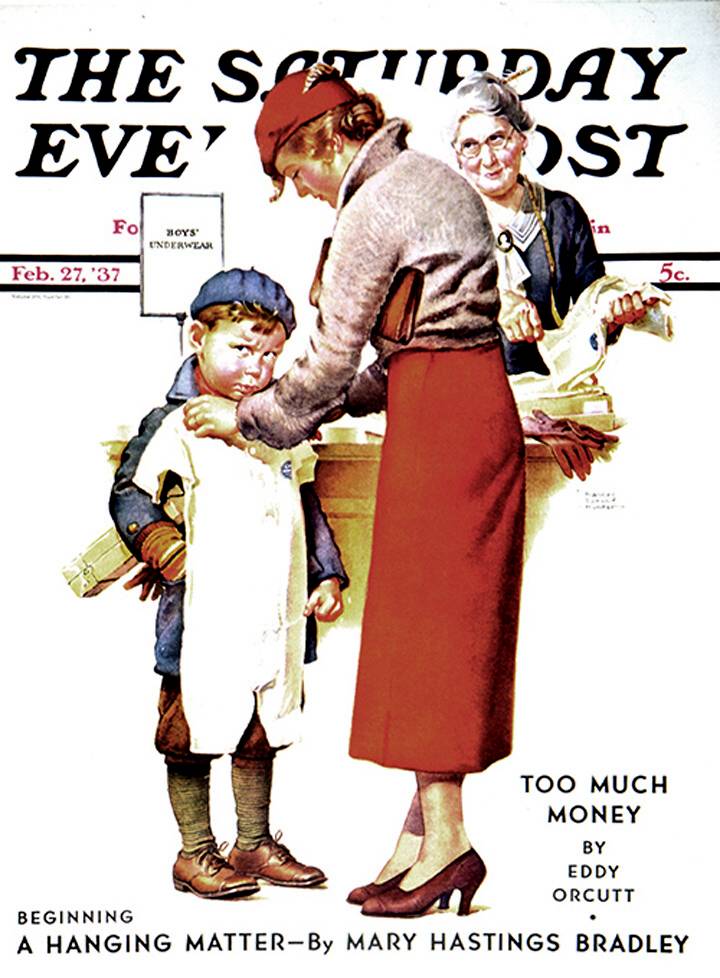 "> ">
Figure 1.--Here we have a 'Saturday Evening Post' cover from the 1930s. Notice the shirtened-length legs, This was to accomdate the knickers the boy is wearing with knee socks. The illustrator was Frances Tipton Hunter. |

|
Winter underwear are virtually unknown to most boys today. Perhaps boys in Canada or American boys on the Northern Plains oe Scandinavian and Russian boys wear them. But for the most part they are no longer common. This is largely because modern homes and schools are so well heated. This was not the case in the 19th and even the early-20th century. It was then very common for boys and girls to wear long underwear as well as other winter items like long stockings, in part because so many boys wore shoertened-length pants like knee pants, knickers, or even short pants.
Generations of Europeamn and Anerican boys grew up wearing long woolen underwear, called long johns, in the winter. It was almost an annual ritual. You knew when winter was approaching when mother brought out the long johns. Then in Spring, you were never quite sure about the end of winter until mother put away the longjohns.
The length of long underwear varied. Standard long johns were done to the ankles. This was the case for adult men who wore long pants. It was a little different for children. Because boys wore shortebned-length pants annd girls dresses with skirts that were about knee length, winter underwear was also done in knee-length verions. he rest of the lehg was covered by knee socks or long stockings which were very common for winterwear into the 1930s. A good example of length is a an American Sear's catalog.
HBC contributors have provided the following accounts on winter underwear.
I remember one of my grandmothers telling me about her childhood on a
farm in Iowa in the 1870s in which she and her brothers and sisters would
be sewn into their heavy knitted woolen underwear in the winter. That era
was reputed to have exceptionally cold and long winters, so it may have
been a practical thing for farm families that lacked running water and
central heat.
My grandmother was a prolific knitter all her life, and knitted heavy
woolen sweaters, caps, scarves, mittens, leggings, and one-piece union
suits of underwear for me when I was a child. We lived in northern
Oklahoma, which had exceptionally cold winters in the 1930s. I was a
"delicate child" with many illnesses, and for reasons of health I was
required to wear woolen underwear from September until May. I wore the
woolen underwear made by my grandmother as well as machine-made woolen
underwear that my mother ordered through the Sears Roebuck catalog. The
suits of underwear made by by grandmother were much heavier than the
Sears underwear, so I would wear the Sears underwear in September and
October, and switch to the heavy underwear after the first frost in
October, and then wear the heavy underwear until continuous mild spring
weather arrived in April. Then I would wear the lighter underwear during
the rest of April and in May. The underwear kept me very warm, and
presumably contributed to my health. Of course I was not sewn into the
underwear.
Knee pants appeared in the mid-19th century, mostly for very young boyus, butthey gradually increased in popularity, becoming stangadard for boy by the 1890s. This was especially true of Americam but also very common in Europw. It appears that one reason that knickers became more popular in the 1910s than knee pants may have been that knickers covered over the long underwear. Wearing long underwear with knee pants could be rather unsightly.
The lack of central heating in the 19th and early-20th century not only mean that winter underwear was common, but also long stockings. It was then very common for boys and girls to wear long underwear as well as other winter items like long stockings, in part because so many boys wore shoertened-length pants like knee pants, knickers, or even short pants or skirts that did not covr he lehs below the knees.
Navigate related Boys' Historical Clothing Web Site cold weather pages pages:
[Return to the Main cold weather wear page]
[Return to the Main wool health page]
[Coats]
[Knits]
[Leggings]
[Sweaters]
[]
[Other cold weather wear]
Navigate the Boys' Historical Clothing Web Site:
[About Us]
[Introduction]
[Activities]
[Biographies]
[Chronology]
[Cloth and textiles]
[Countries]
[Garments]
[Girls]
[Photography]
[Topics]
[Bibliographies]
[Contributions]
[FAQs]
[Glossaries]
[Images]
[Links]
[Registration]
[Search]
[Tools]
[Boys' Clothing Home]
